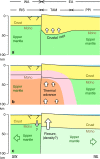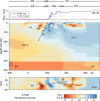Uplift of the central transantarctic mountains
- PMID: 29150611
- PMCID: PMC5693935
- DOI: 10.1038/s41467-017-01577-2
Uplift of the central transantarctic mountains
Erratum in
-
Author Correction: Uplift of the central transantarctic mountains.Nat Commun. 2018 Feb 16;9(1):740. doi: 10.1038/s41467-018-03349-y. Nat Commun. 2018. PMID: 29453353 Free PMC article.
Abstract
The Transantarctic Mountains (TAM) are the world's longest rift shoulder but the source of their high elevation is enigmatic. To discriminate the importance of mechanical vs. thermal sources of support, a 550 km-long transect of magnetotelluric geophysical soundings spanning the central TAM was acquired. These data reveal a lithosphere of high electrical resistivity to at least 150 km depth, implying a cold stable state well into the upper mantle. Here we find that the central TAM most likely are elevated by a non-thermal, flexural cantilever mechanism which is perhaps the most clearly expressed example anywhere. West Antarctica in this region exhibits a low resistivity, moderately hydrated asthenosphere, and concentrated extension (rift necking) near the central TAM range front but with negligible thermal encroachment into the TAM. Broader scale heat flow of east-central West Antarctica appears moderate, on the order of 60-70 mW m-2, lower than that of the U.S. Great Basin.
Conflict of interest statement
The authors declare no competing financial interests.
Figures






References
-
- Wernicke B, et al. Origin of high mountains in the continents: the Southern Sierra Nevada. Science. 1996;271:190–193. doi: 10.1126/science.271.5246.190. - DOI
-
- Turcotte, D. & Schubert, G. Geodynamics 2nd edn (Cambridge Univ. Press, Cambridge, 2002).
-
- Gilbert H, et al. Imaging lithospheric foundering in the structure of the Sierra Nevada. Geosphere. 2012;8:1310–1330. doi: 10.1130/GES00790.1. - DOI
-
- Wannamaker P, et al. Lithospheric dismemberment and magmatic processes of the Great Basin-Colorado Plateau transition, Utah, implied from magnetotellurics. Geochem. Geophys. Geosyst. 2006;9:Q05019.
Publication types
LinkOut - more resources
Full Text Sources
Other Literature Sources

